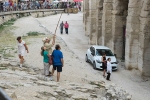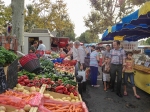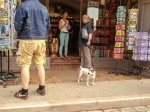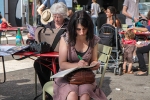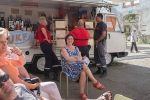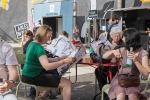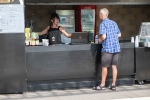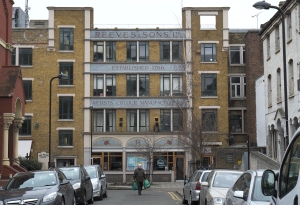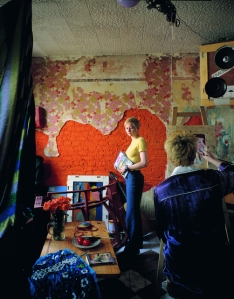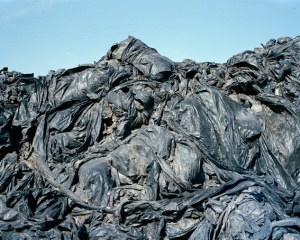Arles in Black
Looking back at my notes I realise I actually forgot another of my aims for the weekend – an unvoiced one at the time which was “To experience creative anarchy”, and that’s what happened as Space, Place, Imagery and Heat combined! What particularly struck me at the time, and has stayed with me, was presentation – how the work was put together conveyed and in what type of space. Of course, whilst reflecting on the impressions since then I’ve also been doing some further research. Don’t know how this will turn out – let’s see. I won’t be writing about all the photographers I saw, just ones that struck me the most at the time. I’m sure I’ll rediscover the others as I continue my journey with the OCA.
Guy Bourdin
Our first Exhibition viewing – in a beautiful building, Espace Van Gogh but within a created, dark space
Bourdin was a fashion photographer between 1955 and 1990. The Arles Catalogue (p.63) describes him as “an autodidact, whose life was devoted to a wide spectrum of artistic research: painting, photography, filming and writing”. I like that word, “autodidact”. – self-directed, learning through a contemplative and absorbed process.
This Exhibition (as other previous Exhibitions) was curated by Shelly Verthime who must know his work so well. 100 manila envelopes, each containing a single negative, with a contact print attached to the front with sticky tape were found by her in 2011 when she was working with Bourdin’s archive. Shelly Verthime has written three books about Bourdin. I know she is London-based but can’t find out who she is, just the occasional comment on the web that refers to her as a Cultural historian, Bourdin’s biographer, art maven. Here Shelly Verthime talks about Bourdin’s use of mirrors in his images
There is magic in the mirror as much as there is magic in Guy Bourdin’s work. With both, the more you look the more you discover. The mirror tells you the truth. (2011 in Dazed Digital website)
According to Linkedin she has an MA from the Royal College of Art. Trying to find out who she was and how, she became involved in the Archives became what I realised was a ‘search for Shelly Verthime” rather than for Guy Bourdin. In fact there was little I can find so I think she must be quite self-effacing. I became curious about her choices of image and presentation from Bourdin’s archive and the fact that, actually, we are seeing him through her eyes as she looks through the mirror.
What I thought as I looked through his fashion images was of how often I might have seen them in magazines in the past and just flicked over the pages so quickly not taking in how he was portraying these beautiful women and his use of layers, sun and shadows. There was much about frames here. The compositional frame and also the image frame. Why were very ornate frames used on some black and white images and not on others? Were these frames ‘old’ or newly created? What did each frame achieve? The ornateness of the frame stopped my eye. I wanted to get rid of the frame to get closer to the image but the frame got in my way. These images were of ‘ordinary’ people including children, and we discussed the intention of the frame. Was it to make these ordinary people special; just as special as elegant and glamorous models or famous people. The polaroids were in the exact centre of a white mount within a white block frame. What if they were swapped with those other frames. How might they look then.
Hiroshi Sugimoto
Revolution
New work in black and white resulting from an out-of-body experience whilst gazing at the horizon and his sense of the earth being a watery globe.
Again the room was dark with the large (2.70m) prints, arrayed around the walls, “that immediately immerse visitors into meditation” (Catalogue contents page). Actually I was immersed into craning my neck to see the images the right way up and wondering why he chose to up-end them. I think the prints were aluminium; certainly the spotlights reflected off them.
Couleurs de l’ombre
The result of Hermès Editeur – editions of works of art on silk, otherwise known as scarves – a project dating back to 1937 and involving collaborations with contemporary artists, the first edition being Josef Albers. Available Sugimoto scarves are retailing at €7,000 according to the Hermes site. I love silk but this is a lot of money!
This series emanated from Colours of Shadow – polaroids by Sugimoto taken at 5.30am every day from late 2009 to the beginning of 2010 through a fascinating process whereby sunlight striking though a prism refracted into colours, which were then projected onto his mirror and reflected into a dim observation chamber where he reduced it to Polaroid colours. (p. 26 Catalogue). In the project with Hermes 20 polaroids were transposed onto silk, in editions of 7 giving a total of 140 scarves each measuring 140cm x 140cm.
The Exhibition was in the Eglise Saint-Blaise which was founded in the 6th Century and abandoned and sold as a national property during the Revolution. Presumably it’s no longer used for religious purposes.
The scarves hanging like pennants on the old stone walls – a gangway for the viewer to walk along (instead of a model wearing one of the scarves); small polaroids contained in glass ; the prism on a plinth where the altar might have been, with the backdrop of “The Last Supper” (from an edition of 5) a print that was damaged in Hurricane Sandy.
To me this Exhibition was about worship – of money and the cost of beautiful objects. It was about patronage of the arts by wealthy benefactors. The pennants of scarves reminded me of the flags hanging from the walls of Churches and Cathedrals. Was this about the glory of Hermes; the glory of Sugimoto’s art? Has Sugimoto given in to the blandishments of wealth and commerce?
Eric Kessels
Eric Kessels is an artist, collector of vernacular photography and co-founder and creative director of KesselsKramer, an independent international communications agency. He had two Exhibitions at Arles in the Palais de l’Archeveche another lovely building with an impressive entrance
Up the stairs we went into rooms full of photographs
24 Hours of Photos
Taking a physical look at 24 hours of digital images uploaded to Flickr. A windowless room flooded with them creeping up the walls. We could look from below and from a platform above.
Actually I could see the installation base underneath so there weren’t as many as there seemed, but still – it was a graphic representation of the way in which we’re deluges with digital images day after day – and contribute. It’s just occurred to me as well that maybe some of my images might be there. What day, month, year?
The Family Album
Several rooms – spacious high-ceilinged with beautiful windows and fireplaces. Photographs – single and in albums – large and small, some stained and creased. In heaps, displayed on the wall in various sizes, printed on rugs on the floors
All those people and discarded memories. It reminded me of clearing my parents’ house after they both died; having to decide what to keep and what to throw away. Think of all those millions of people who go through the same process. I just wonder if any of them were there in those rooms in Arles and recognised a relative.
There is a quote by Kesslers in the catalogue (p. 346)
A long and dedicated search through photo albums will occasionally reveal something less than perfection, something other than an entry in the competition to appear normal. And in these cracks, beauty may be found.
I think he created such poignant beauty there in Arles. I sense a tenderness in the way he put all those images together and considered them worthy of display.
Some Conclusions
Here has been just a snapshot of images seen and places visited in the old City of Arles with its beautiful, old buildings. Thinking about it now I realise that I was more affected by Exhibitions in those buildings than the ones in the Ateliers. The environment does make a difference (at least to me) so does this mean I’m more concerned with style than content – something I need to think about. As a postscript to that, I had wanted to see Bibi the Exhibition of photographs by Jacques Henri Lartigue. The Exhibition had been in Eglise des Trinitaires but had closed by the time we arrived. However I did have an opportunity to see it on a visit recently with John to the Photographers Gallery . It was a busy day for the Gallery, with a group of young people on a guided tour with one of the Exhibition staff. The Photographers Gallery is plain, modern, the talk was loud and distracting. I looked at the images and thought, “Family photos with a flair. Wealthy people in wealthy places. Interesting as a historical record on dress and lifestyle etc.”. I talked with John about it and he said the photographs looked very different here in a plainer environment than they did for him in that Church in Arles.
The Bibi photographs reminded me of visiting Polesden Lacey in Surrey – home of Mrs Greville an Edwardian hostess and friendly with Edward VII and his coterie. Earlier than Lartigue but still that rich lifestyle and many photographs from that era scattered around the luxurious rooms. Sounds like Kessler’s Exhibition a little maybe, although his images were of ordinary people doing ordinary things. No less interesting for that!
I think my Arles experience will stay with me for quite a while. I learned more about the difference that presentation and the environment can make to a viewing experience. Another aspect for me is that I felt much more connected with those photographs from Kessler’s, the Family Album than I did with that Flickr River and its torrents.
References
Les Recontres Arles Photography (2013), Arles in Black, Actes Sud 2013
http://www.dazeddigital.com/artsandculture/article/5378/1/guy-bourdin-ses-films [accessed 24.10.13]
















